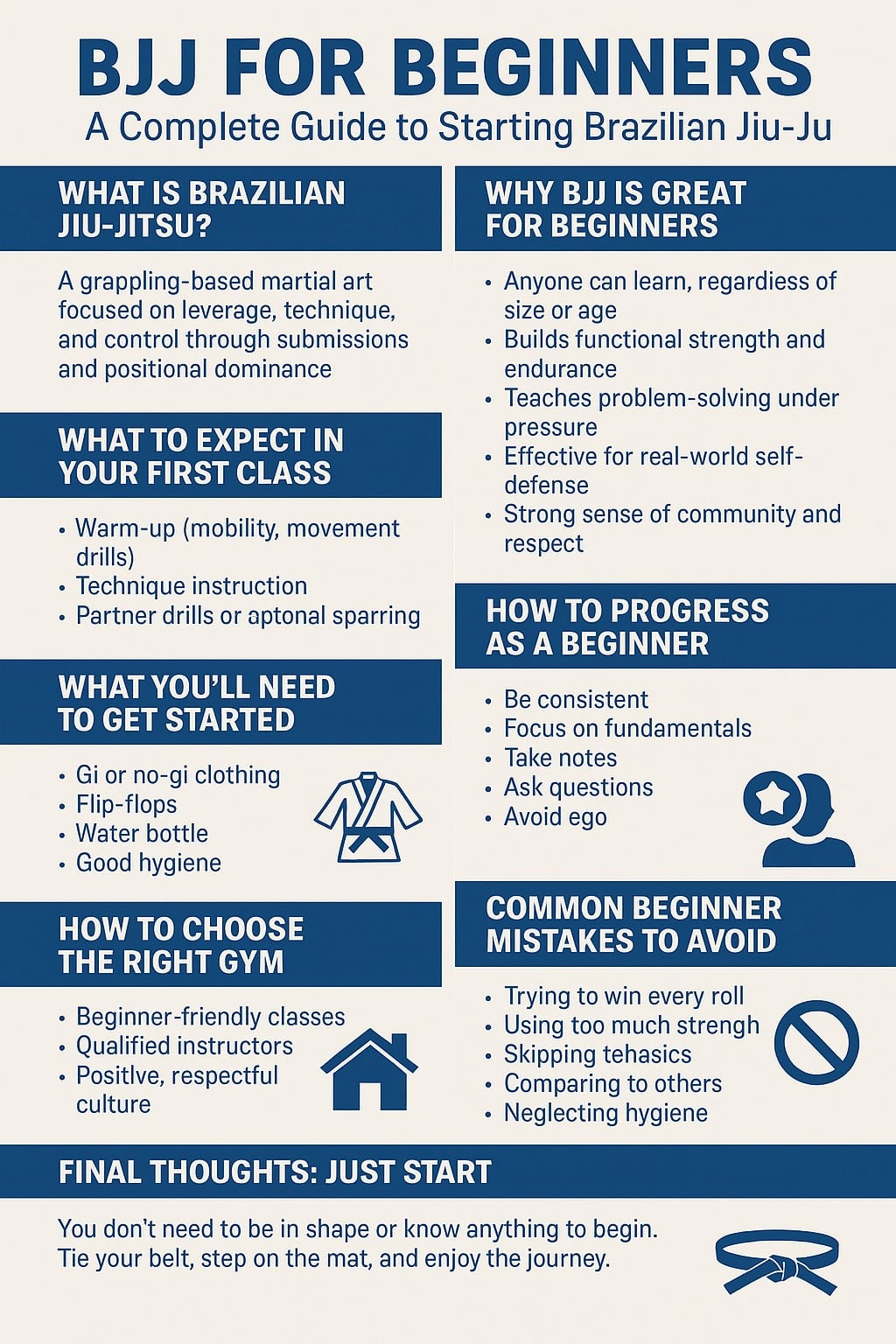BJJ for Beginners: A Complete Guide to Starting Brazilian Jiu-Jitsu
Starting Brazilian Jiu-Jitsu (BJJ) can feel intimidating, but it doesn’t have to be. Whether you’re training for self-defense, fitness, or competition, Brazilian Jiu-Jitsu (BJJ) offers a unique combination of physical challenge, problem-solving, and personal growth.
This guide covers everything beginners need to know before stepping on the mats, from choosing a gym to understanding the culture and setting realistic goals.
What Is Brazilian Jiu-Jitsu?
Brazilian Jiu-Jitsu is a grappling-based martial art that focuses on leverage, technique, and control. Unlike striking arts, BJJ emphasizes submissions, escapes, and positional dominance. The goal is to control or neutralize your opponent using joint locks and chokeholds, regardless of size or strength differences.

Why BJJ Is Great for Beginners
- Anyone can learn — regardless of size, age, or athletic background.
- Builds functional strength, endurance, and flexibility.
- Teaches problem-solving under pressure.
- One of the most effective martial arts for real-world self-defense.
- Strong sense of community, respect, and personal development.
What to Expect in Your First Class
Your first BJJ class will usually include:
- Warm-up (mobility, bodyweight exercises, movement drills)
- Technique instruction (escapes, sweeps, or submissions)
- Partner drills to practice the technique
- Optional sparring (“rolling”) depending on the school
You won’t be expected to know anything, show up ready to learn and listen.
What You’ll Need to Get Started
Clothing depends on the type of BJJ:
- Gi BJJ: You’ll need a kimono-style gi with a white belt (most gyms have loaners).
- No-Gi BJJ: Wear rashguards, athletic shorts (no zippers), and compression gear.
Also bring:
- Flip-flops (for off the mats)
- Water bottle
- Good hygiene (short nails, clean gear)
How to Choose the Right Gym
Not all BJJ gyms are the same. Look for:
- Beginner-friendly classes
- Qualified instructors (black or brown belts)
- Positive, respectful culture
Try a free trial class before committing to a membership.
A guide to Brazilian Jiu Jitsu Schools near you.
How to Progress as a Beginner
- Be consistent: Show up 2–3 times a week. Repetition builds skill.
- Focus on fundamentals: Posture, escapes, and base before submissions.
- Take notes: Write down techniques after class to improve retention.
- Ask questions: Your instructors and partners want to help.
- Avoid ego: Tapping is part of learning, not losing.
Common Beginner Mistakes to Avoid
- Trying to win every roll instead of learning
- Using too much strength or holding your breath
- Skipping the basics for flashy submissions
- Comparing your progress to others
- Neglecting hygiene
Should Beginners Spar?
Yes, but only when appropriate.
- Start sparring after a few classes, when your coach says you’re ready.
- Spar with upper belts who can go light and controlled.
- Focus on applying what you’ve learned, not winning rounds.
Recommended Resources for Beginners
- Instructionals: Start with fundamentals (e.g., John Danaher’s “Enter the System”)
- YouTube: Follow channels focused on concepts, not flashy moves
- Books: Jiu-Jitsu University by Saulo Ribeiro is a classic
- Apps: Use BJJ journals or flowchart tools to track your learning
Final Thoughts: Just Start
You don’t need to be in shape or have any prior knowledge to get started. Just start.
BJJ is one of the most rewarding paths you can take, physically, mentally, and socially. You’ll get fitter, tougher, and more confident. You’ll also make mistakes, get humbled, and grow stronger from it.
Everyone was a beginner once. Tie your belt, step on the mat, and enjoy the journey.
Related Reading
- The Best Ways to Learn Brazilian Jiu Jitsu
- Explore the Best Instructional Videos
- The Top BJJ GI Brand List